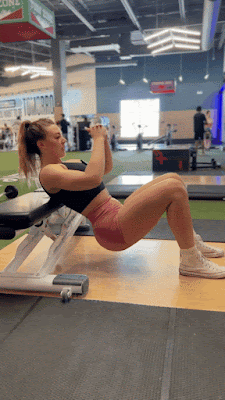Here's a workout targeting the arms and shoulders specifically designed for women. Perform each exercise for 12-15 repetitions and complete the entire circuit for 2-3 rounds. Use weights that challenge you but allow you to maintain proper form.
**1. Bicep Curls:
- Stand with feet hip-width apart, holding dumbbells in each hand, palms facing forward.
- Keep elbows close to your body and curl the weights toward your shoulders.
- Lower the weights back down with control.
**2. Shoulder Press:
- Hold dumbbells at shoulder height with palms facing forward.
- Press the weights overhead, fully extending your arms.
- Lower the weights back down to shoulder height.
**3. Tricep Dips:
- Sit on a bench or chair, placing your hands next to your hips.
- Slide your hips off the bench and lower your body, bending your elbows.
- Push through your palms to return to the starting position.
**4. Front Raises:
- Stand with dumbbells in front of your thighs, palms facing your body.
- Lift the weights directly in front of you to shoulder height.
- Lower the weights back down.
**5. Lateral Raises:
- Hold dumbbells by your sides with palms facing your body.
- Lift the weights out to the sides until they reach shoulder height.
- Lower the weights back down.
**6. Hammer Curls:
- Stand with dumbbells in each hand, palms facing your body.
- Curl the weights toward your shoulders, keeping the palms facing your body throughout the movement.
- Lower the weights with control.
**7. Reverse Flyes:
- Hold dumbbells in front of you with palms facing each other.
- Hinge at your hips, keeping a slight bend in your knees.
- Lift the weights out to the sides, squeezing your shoulder blades together.
- Lower the weights back down.
**8. Overhead Tricep Extension:
- Hold a dumbbell with both hands overhead.
- Lower the weight behind your head, keeping your elbows close to your ears.
- Extend your arms back up to the starting position.
**9. Bent-Over Rows:
- Stand with a dumbbell in each hand, hinge at your hips, keeping your back flat.
- Pull the weights toward your hips, squeezing your shoulder blades.
- Lower the weights back down with control.
**10. Push-Ups: - Start in a plank position with hands slightly wider than shoulder-width apart. - Lower your body toward the ground by bending your elbows. - Push through your palms to return to the starting position.
Remember to warm up before starting the workout, and cool down afterward to stretch and promote flexibility. Adjust the weights according to your fitness level and gradually increase intensity as you progress. Consult with a fitness professional or healthcare provider if you have any concerns or health conditions.




.gif)

.gif)

